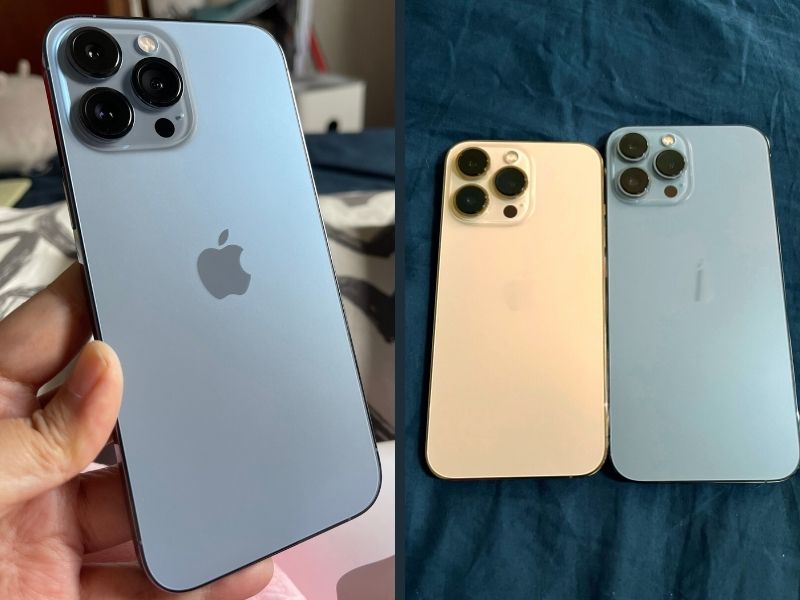KUALA LUMPUR, OCT 25 — The new iPhone 13 Pro models are proving to be rather popular — at time of writing, two Malaysian official Apple resellers have already run out of stock of the larger “Max” version.
Fancy ordering the phone from the official online Apple webstore instead?
Expect a four to five week wait and that might be longer given that year-end is also the holiday season, but a global chip shortage also means fewer devices overall to go around.
The question is, then, whether it’s worth waiting for this year’s iPhones or wait even longer for the iPhone 14 series that are rumoured to be a major design refresh.
All in the hands
The iPhone 13 Pro models have the same sized 6.1-inch and 6.7-inch displays of the iPhone 12 Pro but that’s where the similarities end, mostly.
You can’t use last year’s phone cases with this year’s models — the new phones are thicker and also noticeably heavier.
There’s of course a new “star” colour in the Sierra Blue. A lighter though slightly muted shade that leans a little grey, it’s a nice change after the darker shades of the last two iterations.
Build-wise I can’t fault it — Apple seems to be going for a sturdier build instead of trying to make it sleeker or lighter.
The matte back has a better grip than last year’s, I feel but the Ceramic Shield on the front is the same as the 12’s.
No matter how Apple says it’s sturdier in the end it’s still made of glass so if you hate seeing scratches get a screen protector and a case.
Speaking of the screen, Apple’s finally added ProMotion tech which it’s already had on the iPad Pro models.
What does this mean? Smoother, zippier framerates and animations and a refresh rate that will easily scale from 10Hz to a maximum of 120Hz, dynamically adapting depending on how you’re using the phone.
Compared to last year’s model, you can see how much brighter the screen is and it makes a huge difference to certain games with 120Hz support, such as Genshin Impact.
The downside of enabling 120Hz on Genshin Impact was that the phone did get warmer but the responsiveness and graphic detail bump was very obvious so I wouldn’t recommend over-long gaming sessions without breaks.
Faster, stronger, choppier?
The very first thing I noticed once the setup on the iPhone 13 Pro phones were done, was how much faster it was to zip from one app to the next.
You never really get used to it — how phones can get so much faster in just a year and the new A15 Bionic could probably have powered an entire room of supercomputers four decades ago.
Still as it’s a new phone and a new iOS update, there are times when the screen will get choppy for no reason but go back to normal.
You’re less likely to see it if you use the phone as a fresh new one without transferring all your settings but the occasional hiccup isn’t a dealbreaker.

Now that camera, however. One reason why you can’t use old 12 Pro cases with the 13 Pro phones is because the camera bump is bigger.
The ultrawide camera now has an f/1.8 aperture, up from last year’s f/2.4 while the wide camera has an f/1.5 aperture. In normal-speak, the new cameras are able to let in more light, resulting in brighter pictures and better detail as well as colour.
Apple also improved its telephoto lens and offers 3x optical zoom from last year’s 2.5x zoom but telephoto will perhaps remain my biggest disappointment with Apple’s phones. It doesn’t make sense to me how all the nearest Android rivals can still beat Apple at, of all things, optical zoom.
Photos are a lot brighter and in low light, you can see better colour as well as detail though of course I must say the best photos on the iPhone, or any smartphone really, are best caught outdoors with a lot of light.
The Photographic Styles mode is interesting as they offer a lot more tweaks without the artificial garishness that filters often produce.
Photographers often have their own preferred settings or styles and this option will help you customise your shots without agonising over which filter to use.
Apple’s iPhones still have no equal in one area, which is video. An update coming this week brings the ProRes format exclusively to the iPhone 13 Pro models with one caveat — the lowest storage model with 128GB can only support shooting video in ProRes at 1080p or Full HD.
You would need an iPhone 13 Pro with at least 256GB of storage to shoot ProRes at 4K which is a bummer but perhaps makes sense considering how much more storage ProRes-shot video would need, which is a lot.
I had a lot of fun with the Cinematic video mode which is very easy to use, with the transition between focus points not being obvious or choppy and is very beginner-friendly.
Macro: Nice idea, tricky execution
At least Apple now has added macro capabilities to the Pro range and I must confess I have not had the best of successes with it.

The way the macro works — you need to first switch to the ultrawide lens (marked “0.5” onscreen) and then get gradually closer to your subject, until the phone figures out you’re trying to do a macro shot.
I find it exasperating.
The macro mode or button has been one of the oldest features you would find on point-and-shoot digital cameras and that little flower icon made macro shots easy for even amateurs like me.
My hands are shaky (thanks, carpal tunnel) so getting a focused macro shot, while the wind swayed whatever plant I was trying to shoot was just not fun.
My advice: get a tripod. You don’t even need an expensive one — I recommend the Ulanzi range that offers mobile phone holders and tripods at reasonable prices. Disclaimer: Ulanzi did not sponsor this mention and I paid for all my product purchases from them.
What is the difference between the macro mode and just taking a close-up? In reality for macro shots with an actual camera, you would have a dedicated macro lens and you would then choose autofocus or manually focusing the lens.
With Apple’s macro, there’s the problem of casting shadow on your subject due to the phone’s proximity and the inability to really control the focus.
Well, as the saying goes, there’s an app for that — the Halide app has now been updated to enable macro shooting not just on the iPhone 13 Pro but any phone, really, though of course your results will vary.
Still, as the owner of a macro clip-on lens, I can say the new macro mode does offer results that are closer to a real camera macro than any phone accessory, imperfect as the process is.
Is it worth waiting a month or so, then?
If your phone is older than an iPhone 11, I’d say yes. Otherwise, it’s not enough of an upgrade from the 12 and I’d argue that unless you plan to be shooting professional video, the iPhone 11 Pro is still a really good phone.
There’s really no guarantee you’ll like the iPhone 14, if that is what it’ll be named, so if your phone is as old as the 6S and you can’t wait much longer, the 13 Pro phones offer a spectacular upgrade in performance across the board.
If you still want one, which do you need? If you intend to use it as a movie making or video capturing device, you should probably go for the larger Max at a capacity higher than 128GB to better utilise the ProRes format.
For everyone else, I’d argue the 6.1-inch is still a fairly large display and you’d get just as much power and camera capabilities. The days of only the Max having the best camera are over — going smaller saves you money without sacrificing performance.
Could you do just as well with an iPhone mini or iPhone 13 instead? Read about it in my next review.
The iPhone 13 Pro and 13 Pro Max are available for order on the Apple website but expect a long wait, or you can also place a booking at your nearest Apple reseller or telco.






















